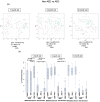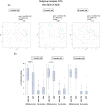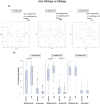Administration of β-lactam antibiotics and delivery method correlate with intestinal abundances of Bifidobacteria and Bacteroides in early infancy, in Japan
- PMID: 33737648
- PMCID: PMC7973812
- DOI: 10.1038/s41598-021-85670-z
Administration of β-lactam antibiotics and delivery method correlate with intestinal abundances of Bifidobacteria and Bacteroides in early infancy, in Japan
Abstract
The intestinal microbiome changes dynamically in early infancy. Colonisation by Bifidobacterium and Bacteroides and development of intestinal immunity is interconnected. We performed a prospective observational cohort study to determine the influence of antibiotics taken by the mother immediately before delivery on the intestinal microbiome of 130 healthy Japanese infants. Faecal samples (383) were collected at 1, 3, and 6 months and analysed using next-generation sequencing. Cefazolin was administered before caesarean sections, whereas ampicillin was administered in cases with premature rupture of the membranes and in Group B Streptococcus-positive cases. Bifidobacterium and Bacteroides were dominant (60-70% mean combined occupancy) at all ages. A low abundance of Bifidobacterium was observed in infants exposed to antibiotics at delivery and at 1 and 3 months, with no difference between delivery methods. A lower abundance of Bacteroides was observed after caesarean section than vaginal delivery, irrespective of antibiotic exposure. Additionally, occupancy by Bifidobacterium at 1 and 3 months and by Bacteroides at 3 months differed between infants with and without siblings. All these differences disappeared at 6 months. Infants exposed to intrapartum antibiotics displayed altered Bifidobacterium abundance, whereas abundance of Bacteroides was largely associated with the delivery method. Existence of siblings also significantly influenced the microbiota composition of infants.
Conflict of interest statement
The authors declare no competing interests.
Figures







Similar articles
-
Maternal diet during pregnancy is related with the infant stool microbiome in a delivery mode-dependent manner.Microbiome. 2018 Jul 5;6(1):109. doi: 10.1186/s40168-018-0490-8. Microbiome. 2018. PMID: 29973274 Free PMC article.
-
Association of birth mode of delivery with infant faecal microbiota, potential pathobionts, and short chain fatty acids: a longitudinal study over the first year of life.BJOG. 2021 Jul;128(8):1293-1303. doi: 10.1111/1471-0528.16633. Epub 2021 Feb 1. BJOG. 2021. PMID: 33338292 Free PMC article.
-
Factors influencing the composition of the intestinal microbiota in early infancy.Pediatrics. 2006 Aug;118(2):511-21. doi: 10.1542/peds.2005-2824. Pediatrics. 2006. PMID: 16882802
-
Association Between the Mode of Delivery and Infant Gut Microbiota Composition Up to 6 Months of Age: A Systematic Literature Review Considering the Role of Breastfeeding.Nutr Rev. 2021 Dec 8;80(1):113-127. doi: 10.1093/nutrit/nuab008. Nutr Rev. 2021. PMID: 33837424
-
The intestinal bacterial colonisation in preterm infants: a review of the literature.Clin Nutr. 2006 Jun;25(3):361-8. doi: 10.1016/j.clnu.2006.03.002. Epub 2006 May 4. Clin Nutr. 2006. PMID: 16677741 Review.
Cited by
-
How aging influences the gut-bone marrow axis and alters hematopoietic stem cell regulation.Heliyon. 2024 Jun 11;10(12):e32831. doi: 10.1016/j.heliyon.2024.e32831. eCollection 2024 Jun 30. Heliyon. 2024. PMID: 38984298 Free PMC article. Review.
-
Parity modulates impact of BMI and gestational weight gain on gut microbiota in human pregnancy.Gut Microbes. 2023 Dec;15(2):2259316. doi: 10.1080/19490976.2023.2259316. Epub 2023 Oct 9. Gut Microbes. 2023. PMID: 37811749 Free PMC article.
-
The Emerging Roles of Human Gut Microbiota in Gastrointestinal Cancer.Front Immunol. 2022 Jun 15;13:915047. doi: 10.3389/fimmu.2022.915047. eCollection 2022. Front Immunol. 2022. PMID: 35784372 Free PMC article. Review.
-
Delivery mode, birth order, and sex impact neonatal microbial colonization.Gut Microbes. 2025 Dec;17(1):2491667. doi: 10.1080/19490976.2025.2491667. Epub 2025 Apr 19. Gut Microbes. 2025. PMID: 40251947 Free PMC article.
-
Quantitative insights into effects of intrapartum antibiotics and birth mode on infant gut microbiota in relation to well-being during the first year of life.Gut Microbes. 2022 Jan-Dec;14(1):2095775. doi: 10.1080/19490976.2022.2095775. Gut Microbes. 2022. PMID: 36174236 Free PMC article.
References
Publication types
MeSH terms
Substances
Associated data
LinkOut - more resources
Full Text Sources
Other Literature Sources
Medical

